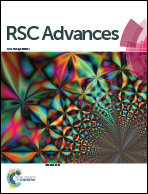Shape-controlled synthesis of PtPd alloys as a low-cost and efficient counter electrode for dye-sensitized solar cells†
Abstract
Dry plasma reduction is an excellent approach for easy synthesis of PtPd alloys with different sizes, shapes (nanoparticles, nanorods, microrods, etc.), and distributions on fluorine-doped tin oxide (FTO) substrates through simply controlling the volume ratio of the Pt and Pd precursor solution under atmospheric pressure near room temperature. Dye-sensitized solar cells (DSCs) utilizing a bimetallic Pt0.5Pd0.5 nanorod counter electrode exhibit better performance than those of DSCs fabricated with Pt and Pd electrodes. The obtained results establish a foundation for the use of PtPd alloy CEs as well as the economic utility of Pt in efficient and low-cost DSCs.



 Please wait while we load your content...
Please wait while we load your content...